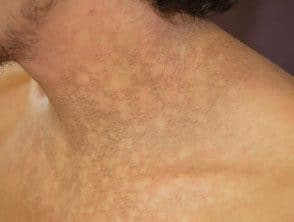What is it confluent and lattice papillomatosis?
Confluent and reticulated papillomatosis is a rare skin condition that affects the trunk, neck, and armpits. It is characterized by asymptomatic, hyperpigmented papules and plates who has a peripheralnet setting.
French dermatologists Gourgerot and Carteaud first described confluent and crosslinked papillomatosis in 1927 [1].
Confluent and reticulated papillomatosis

Confluent and reticulated papillomatosis

Confluent and reticulated papillomatosis

Confluent and reticulated papillomatosis
Who gets confluent and reticulated papillomatosis?
Confluent and reticulated papillomatosis occurs mainly in young adults. The average age of incidence it is 15 years old, with a range of 8 to 32 years [2]. It has been reported worldwide in all racial and ethnic groups, but is reported to be more common in Caucasians [3].
What is the cause of confluent and reticulated papillomatosis?
What triggers the confluent and reticulated papillomatosis remains unclear. Messy and hyperproliferative. keratinization has been observed in light and electrons microscopy [4.5]. The possibility that this is due to the skin infection is backed by the success of antibiotic treatment.
- Papillomatosis of Dietzia is the current leading infectious candidate. This is a gram-positive actinomycete that was first isolated from a patient with confluent and reticulated papillomatosis in 2005 [5,6].
- Previous observations that antifungal agents were effective, supporting the role of Malassezia furfur at Pathogenesis, probably due to a misdiagnosis of pityriasis versicolor [2,8].
Genetic Factors may also be involved.
- Various cases of family Confluent and reticulated papillomatosis have been reported [9,10].
- Mutation of the gene for protein curb-16 (K-16) has been found in some cases [11].
Insulin resistance, which causes diabetes mellitus and polycystic ovary syndrome, has been suggested as a contributing factor to confluent and reticulated papillomatosis, but the evidence is weak, since the majority of affected patients do not have metabolic syndrome [12,13].
Amyloidosis and reaction to ultraviolet light have also been considered, but are unlikely causes. [14,15].
What are the clinical features of confluent and reticulated papillomatosis?
Confluent and reticulated papillomatosis is characterized by multiples of 1 to 5 mm, hyperpigmented, scaly macules or papillomatous papules
- These often form centrally confluent patches or plates, and a lattice peripheral pattern.
- They most commonly occur in the upper part of the trunk, neck and armpits. They can also extend anteriorly to the pubic region and later to the natality. cleft. The antecubital and popliteal the fossae and forehead are rarely affected [16–18].
- the eruption does not imply mucous membrane surfaces o nail.
- The lesions are asymptomatic or slightly itchy.
Which is the differential diagnosis of confluent and reticulated papillomatosis?
The most common conditions that mimic the morphology me distribution of confluent and reticulated papillomatosis are:
- Acanthosis nigricans, which is associated with obesity and insulin resistance. Pigmentation it is not associated with peripheral crosslinking [19].
-
Pityriasis versicolor, which has positive microscopy and disappears with antifungal treatment.
Less common disorders that may need to be considered in the differential include:
- Darier's disease
- Dowling-Degos disease and Galli-Galli disease
- Epidermal nevus
- Verruciform epidermodysplasia
- Flat warts
- Dyskeratosis congenital
- Prurigo pigment
- Dermatitis neglecta
- Terra signature-form skin disease
- Lichen o macular amyloidosis.
How is confluent and reticulated papillomatosis diagnosed?
Diagnosis of confluent and reticulated papillomatosis is based on identifying typical clinical features and excluding fungal infection by microscopy and culture of scale (See mycology of dermatophyte infections).
Davis et al have proposed a set of diagnostic criteria for confluent and reticulated papillomatosis [2].
- Clinical findings are brown, scaly macules and patches, at least part of which appear reticulated and papillomatous.
- the eruption It affects the upper part of the trunk and the neck.
- Microscopy and scale culture are negative for fungi.
- The rash does not respond to antifungal treatment.
- It has an excellent response to minocycline.
This set of criteria has shown good agreement with other large series of cases. [19].
Skin biopsy It may be indicated to exclude other diagnoses.
What is the treatment for confluent and reticulated papillomatosis?
Confluent and crosslinked papillomatosis usually clears with a tetracycline (minocycline, doxycycline for 6 to 12 weeks) or a macrolide antibiotic (azithromycin, clarithromycin, erythromycin for 4 to 6 weeks) [2,20,21]. Azithromycin and erythromycin can be prescribed in pregnancy. [22–24]
Current tazarotene (a topic retinoid), tacrolimus and calcipotriol) can be used to located disease [25–27].
Systematic retinoids (Isotretinoin and acitretin) are generally reserved for cases refractory to antibiotics and topical agents [28].
What is the prognosis for confluent and reticulated papillomatosis?
A single course of minocycline or a macrolide antibiotic is reported to lead to remission for up to 2 years in many cases of confluent and reticulated papillomatosis [2,21,29].
Reappearance In up to 15% of cases, a non-antibacterial treatment is generally followed.
Spontaneous resolution has been reported in some cases, but it can take up to 39 months for the rash to go away. [30].

